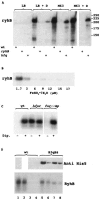Characterization of the small untranslated RNA RyhB and its regulon in Vibrio cholerae
- PMID: 15937163
- PMCID: PMC1151736
- DOI: 10.1128/JB.187.12.4005-4014.2005
Characterization of the small untranslated RNA RyhB and its regulon in Vibrio cholerae
Abstract
Numerous small untranslated RNAs (sRNAs) have been identified in Escherichia coli in recent years, and their roles are gradually being defined. However, few of these sRNAs appear to be conserved in Vibrio cholerae, and both identification and characterization of sRNAs in V. cholerae remain at a preliminary stage. We have characterized one of the few sRNAs conserved between E. coli and V. cholerae: RyhB. Sequence conservation is limited to the central region of the gene, and RyhB in V. cholerae is significantly larger than in E. coli. As in E. coli, V. cholerae RyhB is regulated by the iron-dependent repressor Fur, and it interacts with the RNA-binding protein Hfq. The regulons controlled by RyhB in V. cholerae and E. coli appear to differ, although some overlap is evident. Analysis of gene expression in V. cholerae in the absence of RyhB suggests that the role of this sRNA is not limited to control of iron utilization. Quantitation of RyhB expression in the suckling mouse intestine suggests that iron availability is not limiting in this environment, and RyhB is not required for colonization of this mammalian host by V. cholerae.
Figures




Similar articles
-
Characterization of Vibrio cholerae RyhB: the RyhB regulon and role of ryhB in biofilm formation.Infect Immun. 2005 Sep;73(9):5706-19. doi: 10.1128/IAI.73.9.5706-5719.2005. Infect Immun. 2005. PMID: 16113288 Free PMC article.
-
Impact of Anaerobiosis on Expression of the Iron-Responsive Fur and RyhB Regulons.mBio. 2015 Dec 15;6(6):e01947-15. doi: 10.1128/mBio.01947-15. mBio. 2015. PMID: 26670385 Free PMC article.
-
CsrA and three redundant small RNAs regulate quorum sensing in Vibrio cholerae.Mol Microbiol. 2005 Nov;58(4):1186-202. doi: 10.1111/j.1365-2958.2005.04902.x. Mol Microbiol. 2005. PMID: 16262799
-
Small RNAs controlling iron metabolism.Curr Opin Microbiol. 2007 Apr;10(2):140-5. doi: 10.1016/j.mib.2007.03.013. Epub 2007 Mar 23. Curr Opin Microbiol. 2007. PMID: 17383226 Review.
-
Non-coding sRNAs regulate virulence in the bacterial pathogen Vibrio cholerae.RNA Biol. 2012 Apr;9(4):392-401. doi: 10.4161/rna.19975. Epub 2012 Apr 1. RNA Biol. 2012. PMID: 22546941 Free PMC article. Review.
Cited by
-
Switching fatty acid metabolism by an RNA-controlled feed forward loop.Proc Natl Acad Sci U S A. 2020 Apr 7;117(14):8044-8054. doi: 10.1073/pnas.1920753117. Epub 2020 Mar 19. Proc Natl Acad Sci U S A. 2020. PMID: 32193348 Free PMC article.
-
A new Vibrio cholerae sRNA modulates colonization and affects release of outer membrane vesicles.Mol Microbiol. 2008 Oct;70(1):100-11. doi: 10.1111/j.1365-2958.2008.06392.x. Epub 2008 Aug 4. Mol Microbiol. 2008. PMID: 18681937 Free PMC article.
-
Post-transcriptional regulation of gene expression in Yersinia species.Front Cell Infect Microbiol. 2012 Nov 9;2:129. doi: 10.3389/fcimb.2012.00129. eCollection 2012. Front Cell Infect Microbiol. 2012. PMID: 23162797 Free PMC article. Review.
-
sRNAPredict: an integrative computational approach to identify sRNAs in bacterial genomes.Nucleic Acids Res. 2005 Jul 26;33(13):4096-105. doi: 10.1093/nar/gki715. Print 2005. Nucleic Acids Res. 2005. PMID: 16049021 Free PMC article.
-
Positive regulation of the Vibrio cholerae porin OmpT by iron and fur.J Bacteriol. 2011 Dec;193(23):6505-11. doi: 10.1128/JB.05681-11. Epub 2011 Sep 30. J Bacteriol. 2011. PMID: 21965571 Free PMC article.
References
-
- Argaman, L., R. Hershberg, J. Vogel, G. Bejerano, E. G. Wagner, H. Margalit, and S. Altuvia. 2001. Novel small RNA-encoding genes in the intergenic regions of Escherichia coli. Curr. Biol. 11:941-950. - PubMed
-
- Asubel, F. M., R. Brent, R. E. Kingston, D. Moore, J. G. Seidman, J. A. Smith, and K. Struhl (ed.). 1995. Current protocols in molecular biology. John Wiley and Sons, Inc., New York, N.Y.
Publication types
MeSH terms
Substances
Grants and funding
LinkOut - more resources
Full Text Sources
Molecular Biology Databases
Research Materials

